Abstract
Mixed preparations of fibroblast and immune interferons interacted with cells synergistically to cause the development of a much greater level of protection than expected on the basis of their separate activities. This increased level of protection was 5- to 20-fold greater than expected on the basis of a simple additive effect of the interferons. The potentiating factor copurified with both fibroblast interferon and immune interferon as they were partially purified. The potentiation was not an artifact of a more rapid development of immune interferon-induced antiviral resistance in the presence of fibroblast interferon. The results were consistent with the hypothesis that fibroblast and immune interferons mutually potentiate each other, thus supporting the supposition that they have different modes of action.
Full text
PDF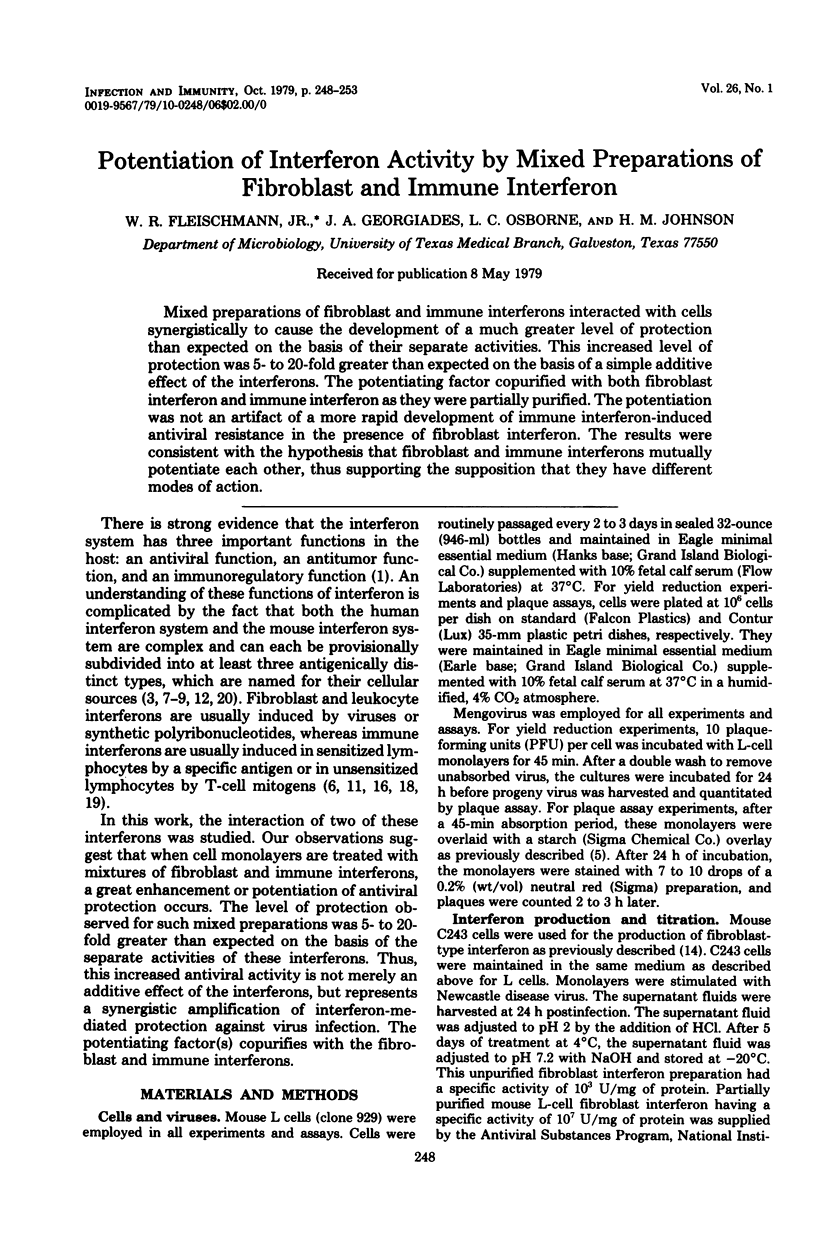
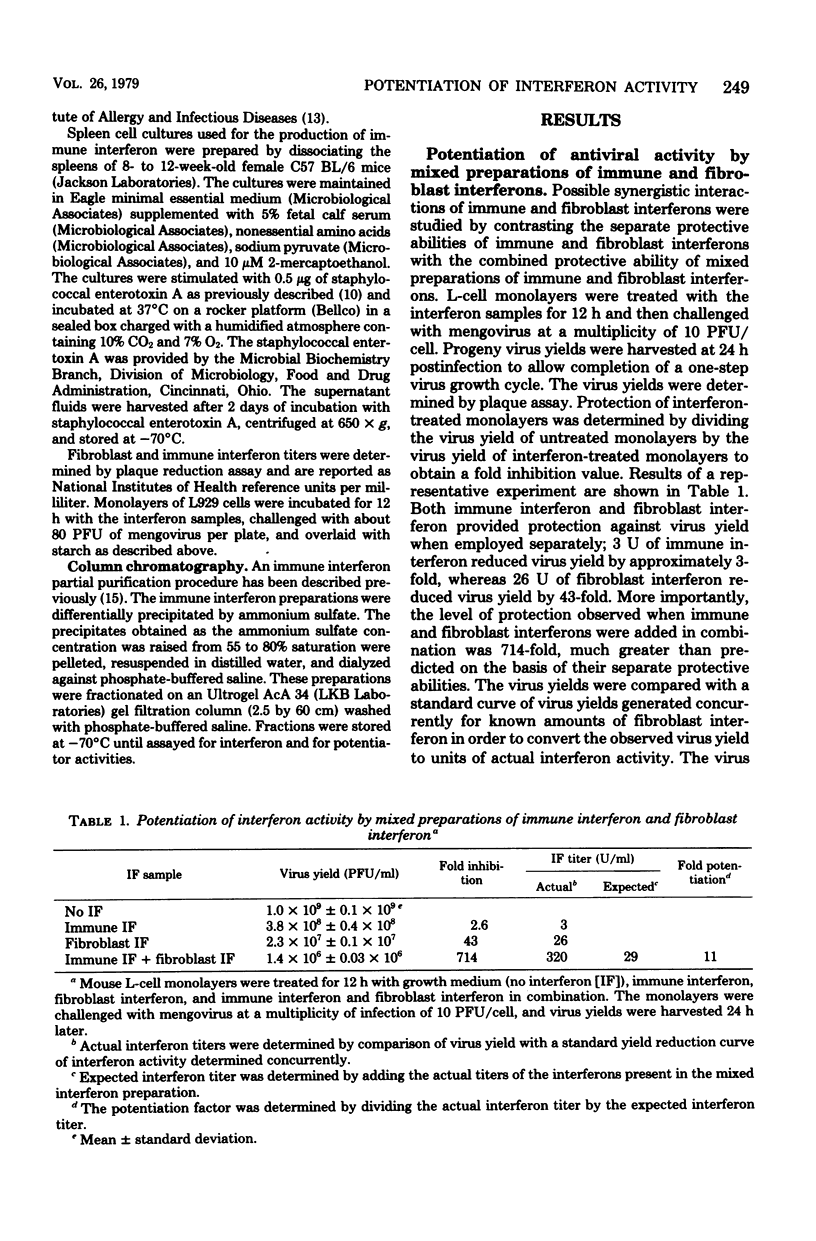
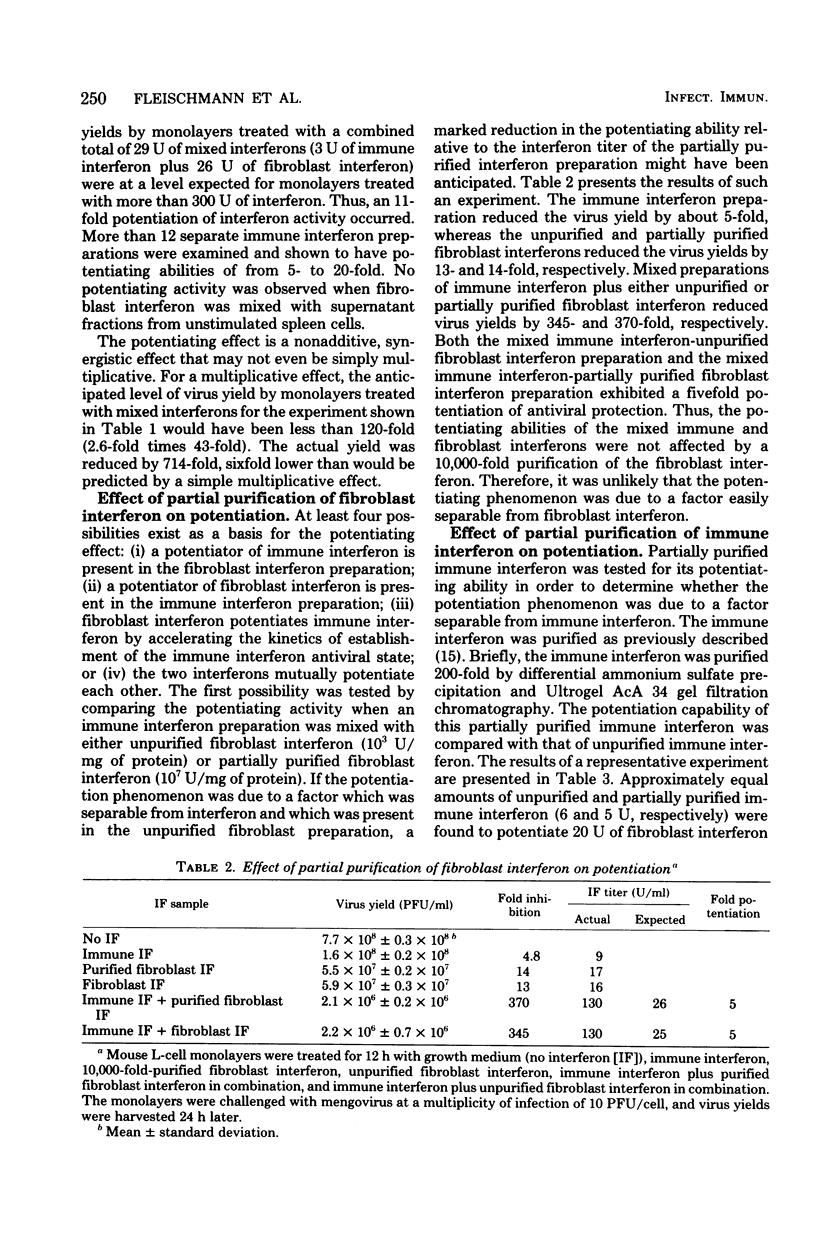
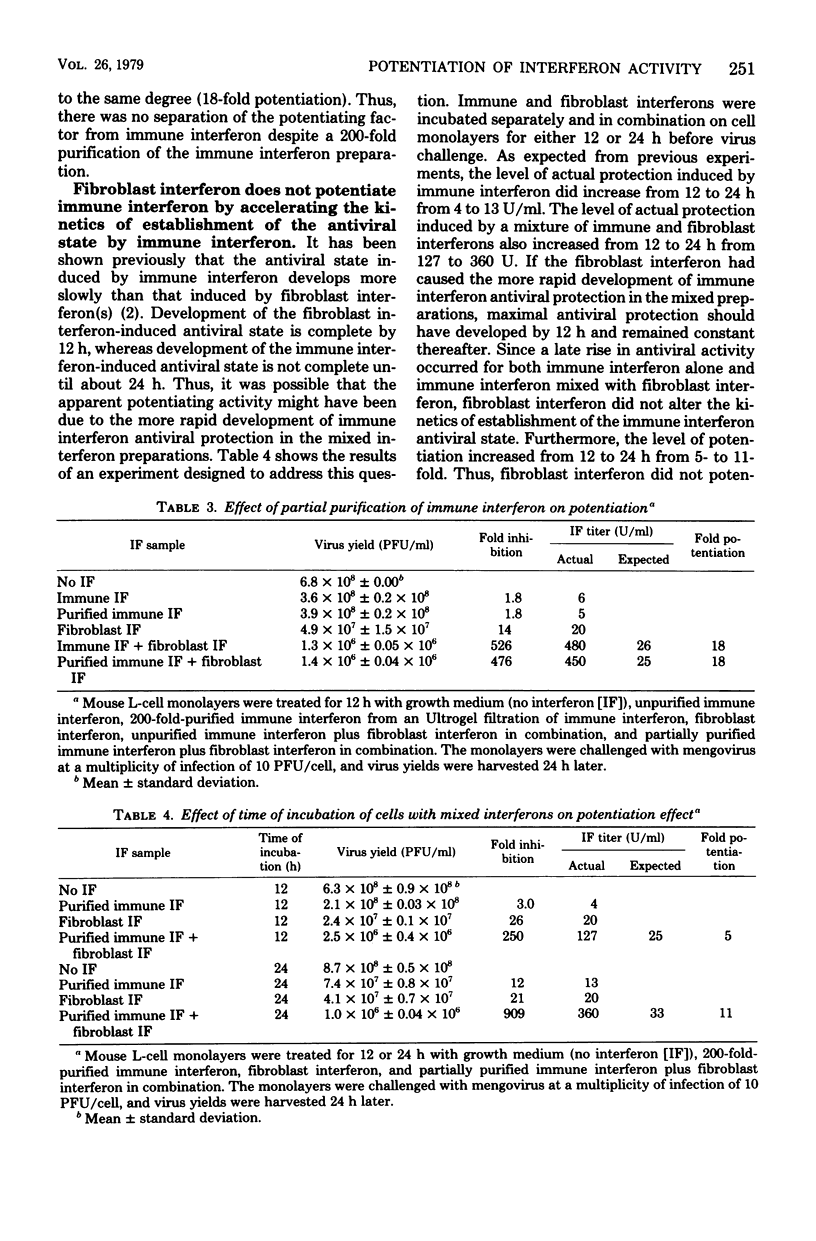
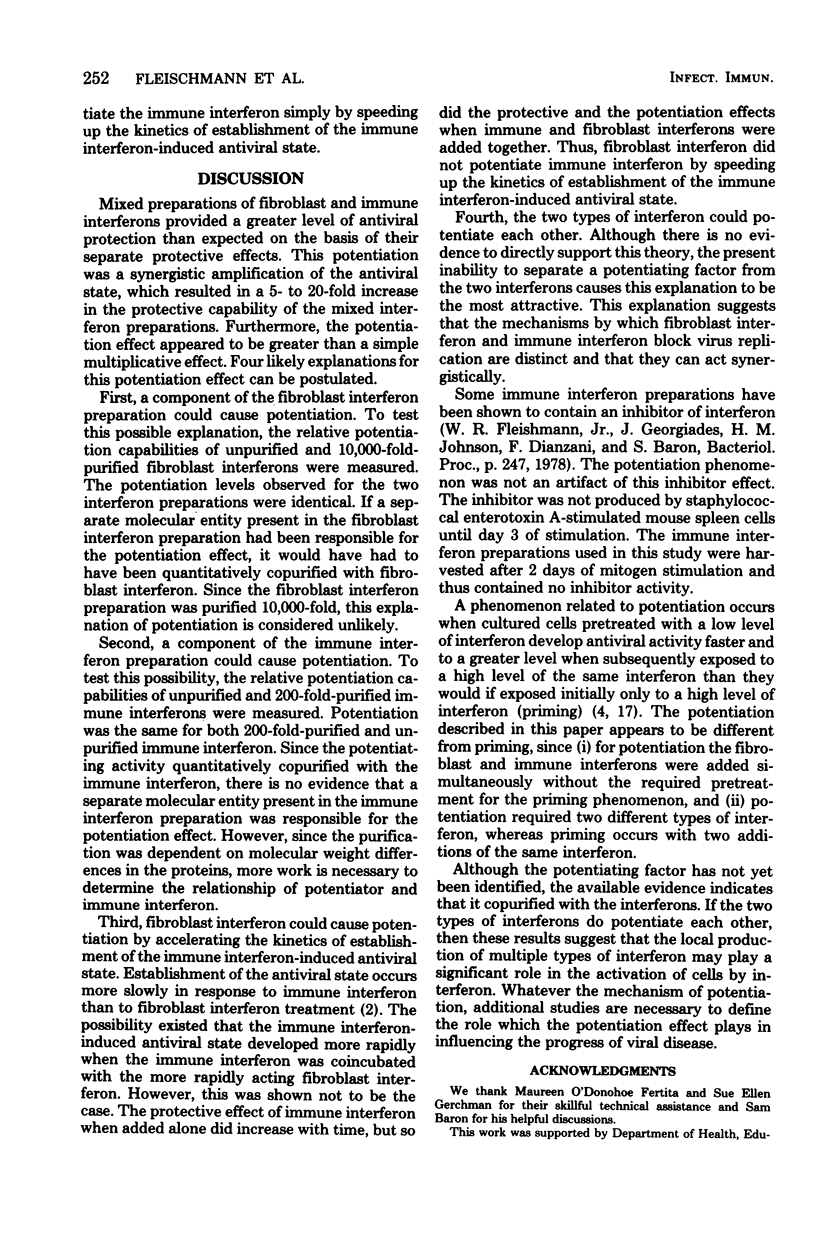
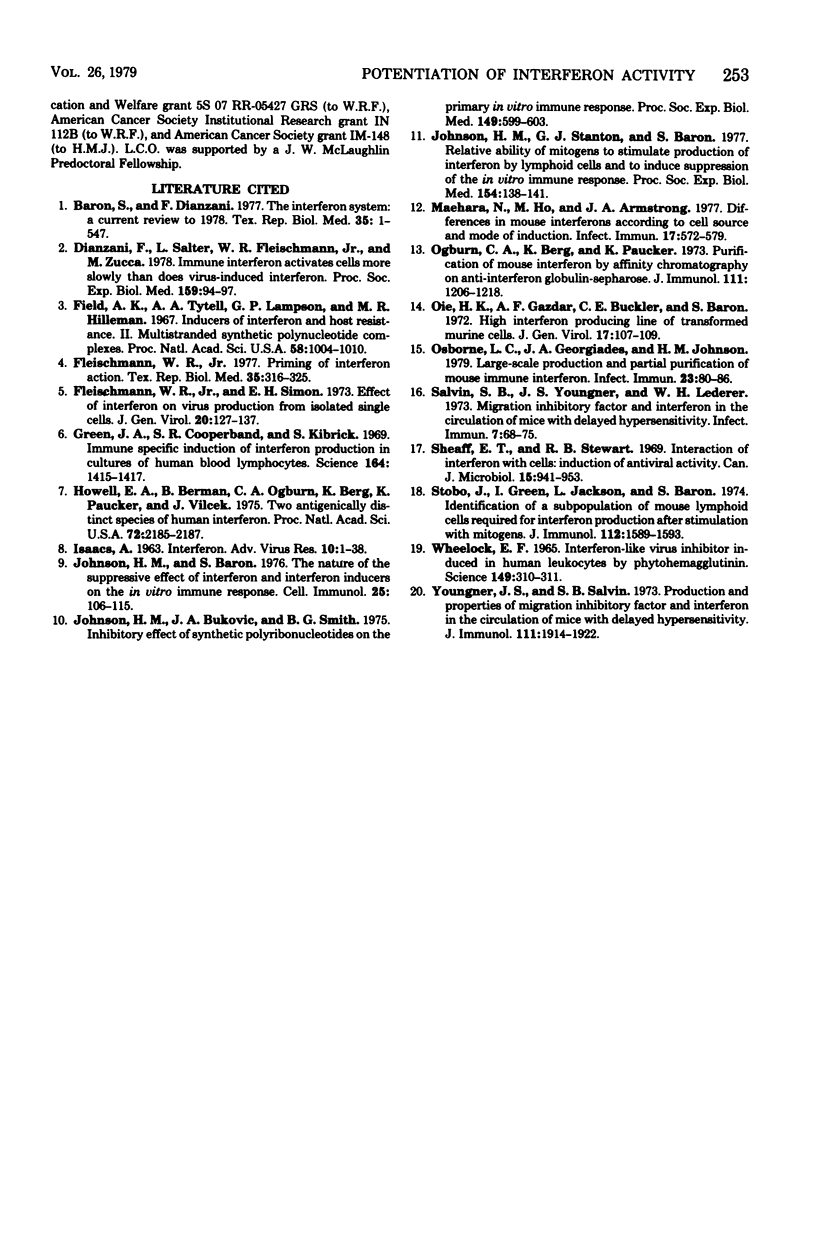
Selected References
These references are in PubMed. This may not be the complete list of references from this article.
- Baron S., Dianzani F. General considerations of the interferon system. Tex Rep Biol Med. 1977;35:1–10. [PubMed] [Google Scholar]
- Dianzani F., Salter L., Fleischmann W. R., Jr, Zucca M. Immune interferon activates cells more slowly than does virus-induced interferon. Proc Soc Exp Biol Med. 1978 Oct;159(1):94–97. doi: 10.3181/00379727-159-40291. [DOI] [PubMed] [Google Scholar]
- Field A. K., Tytell A. A., Lampson G. P., Hilleman M. R. Inducers of interferon and host resistance. II. Multistranded synthetic polynucleotide complexes. Proc Natl Acad Sci U S A. 1967 Sep;58(3):1004–1010. doi: 10.1073/pnas.58.3.1004. [DOI] [PMC free article] [PubMed] [Google Scholar]
- Fleischmann W. R., Jr Priming of interferon action. Tex Rep Biol Med. 1977;35:316–325. [PubMed] [Google Scholar]
- Fleischmann W. R., Simon E. H. Effect of interferon on virus production from isolated single cells. J Gen Virol. 1973 Aug;20(2):127–137. doi: 10.1099/0022-1317-20-2-127. [DOI] [PubMed] [Google Scholar]
- Green J. A., Cooperband S. R., Kibrick S. Immune specific induction of interferon production in cultures of human blood lymphocytes. Science. 1969 Jun 20;164(3886):1415–1417. doi: 10.1126/science.164.3886.1415. [DOI] [PubMed] [Google Scholar]
- Havell E. A., Berman B., Ogburn C. A., Berg K., Paucker K., Vilcek J. Two antigenically distinct species of human interferon. Proc Natl Acad Sci U S A. 1975 Jun;72(6):2185–2187. doi: 10.1073/pnas.72.6.2185. [DOI] [PMC free article] [PubMed] [Google Scholar]
- ISAACS A. INTERFERON. Adv Virus Res. 1963;10:1–38. [PubMed] [Google Scholar]
- Johnson H. M., Baron S. The nature of the suppressive effect of interferon and interferon inducers on the in vitro immune response. Cell Immunol. 1976 Jul;25(1):106–115. doi: 10.1016/0008-8749(76)90100-3. [DOI] [PubMed] [Google Scholar]
- Johnson H. M., Bukovic J. A., Smith B. G., Baron S. Inhibitory effect of synthetic polyribonucleotides on the primary in vitro immune response. Proc Soc Exp Biol Med. 1975 Jul;149(3):599–603. doi: 10.3181/00379727-149-38860. [DOI] [PubMed] [Google Scholar]
- Johnson H. M., Stanton G. J., Baron S. Relative ability of mitogens to stimulate production of interferon by lymphoid cells and to induce suppression of the in vitro immune response. Proc Soc Exp Biol Med. 1977 Jan;154(1):138–141. [PubMed] [Google Scholar]
- Maehara N., Ho M., Armstrong J. A. Differences in mouse interferons according to cell source and mode of induction. Infect Immun. 1977 Sep;17(3):572–579. doi: 10.1128/iai.17.3.572-579.1977. [DOI] [PMC free article] [PubMed] [Google Scholar]
- Ogburn C. A., Berg K., Paucker K. Purification of mouse interferon by affinity chromatography on anti-interferon globulin-sepharose. J Immunol. 1973 Oct;111(4):1206–1218. [PubMed] [Google Scholar]
- Oie H. K., Gazdar A. F., Buckler C. E., Baron S. High interferon producing line of transformed murine cells. J Gen Virol. 1972 Oct;17(1):107–109. doi: 10.1099/0022-1317-17-1-107. [DOI] [PubMed] [Google Scholar]
- Osborne L. C., Georgiades J. A., Johnson H. M. Large-scale production and partial purification of mouse immune interferon. Infect Immun. 1979 Jan;23(1):80–86. doi: 10.1128/iai.23.1.80-86.1979. [DOI] [PMC free article] [PubMed] [Google Scholar]
- Salvin S. B., Youngner J. S., Lederer W. H. Migration inhibitory factor and interferon in the circulation of mice with delayed hypersensitivity. Infect Immun. 1973 Jan;7(1):68–75. doi: 10.1128/iai.7.1.68-75.1973. [DOI] [PMC free article] [PubMed] [Google Scholar]
- Sheaff E. T., Stewart R. B. Interaction of interferon with cells: induction of antiviral activity. Can J Microbiol. 1969 Aug;15(8):941–953. doi: 10.1139/m69-165. [DOI] [PubMed] [Google Scholar]
- Stobo J., Green I., Jackson L., Baron S. Identification of a subpopulation of mouse lymphoid cells required for interferon production after stimulation with mitogens. J Immunol. 1974 Apr;112(4):1589–1593. [PubMed] [Google Scholar]
- Wheelock E. F. Interferon-Like Virus-Inhibitor Induced in Human Leukocytes by Phytohemagglutinin. Science. 1965 Jul 16;149(3681):310–311. doi: 10.1126/science.149.3681.310. [DOI] [PubMed] [Google Scholar]
- Youngner J. S., Salvin S. B. Production and properties of migration inhibitory factor and interferon in the circulation of mice with delayed hypersensitivity. J Immunol. 1973 Dec;111(6):1914–1922. [PubMed] [Google Scholar]


